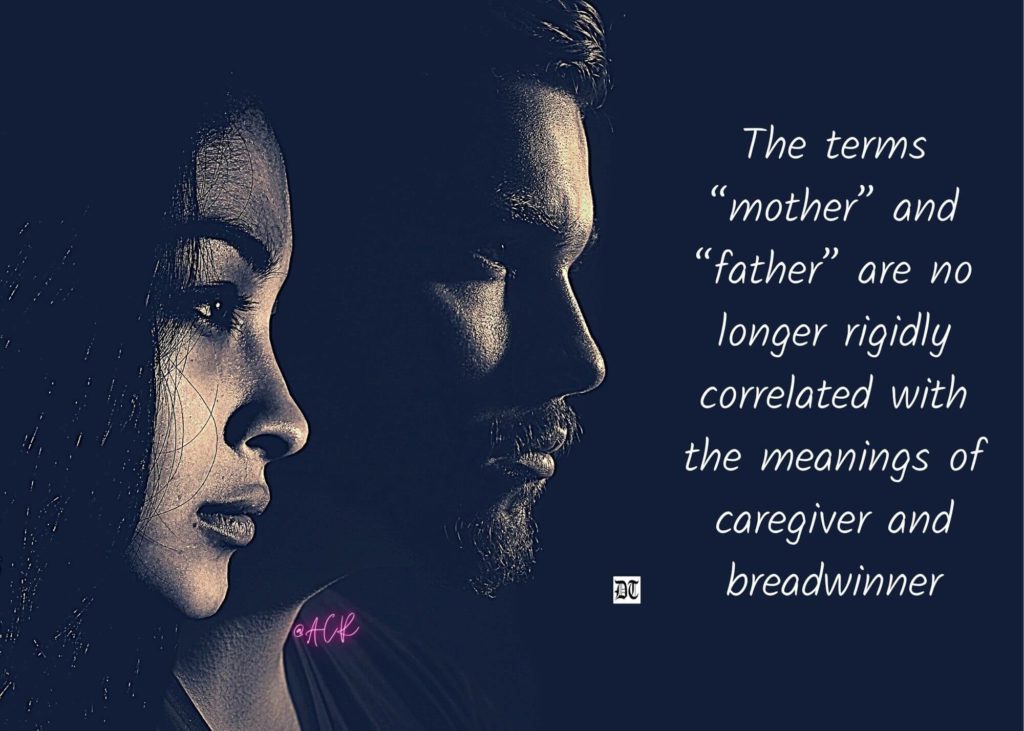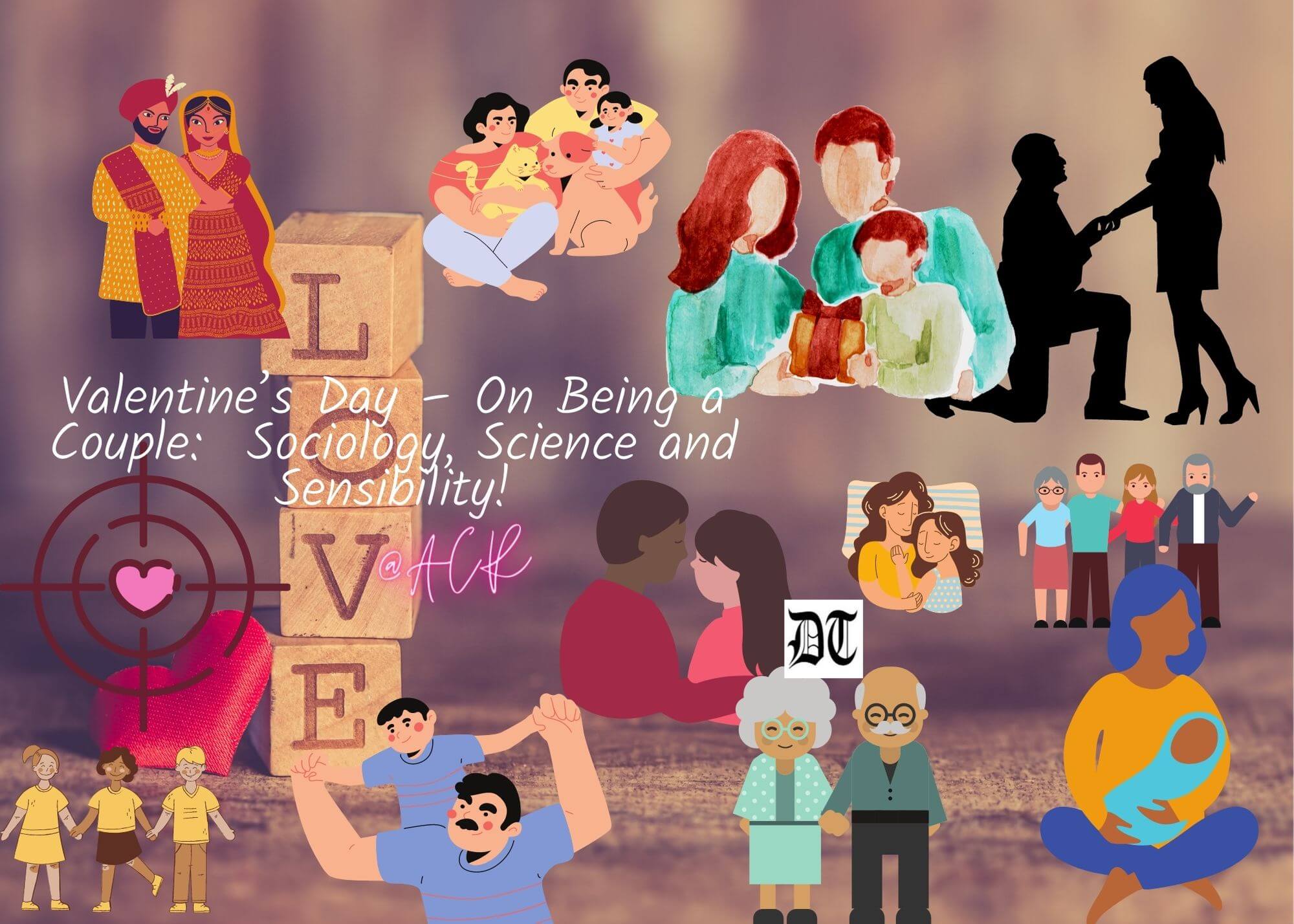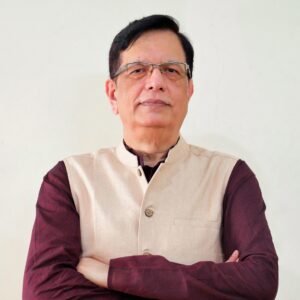On the eve of Valentine’s Day, Ram Krishna critiques the meanings of couple and marriage. He explores the layers of sociology, science, and sensibility. An exclusive for Different Truths.
The ramification of forgetting marriage anniversary day is well understood by all husbands on this planet. The fallout-experience is a universal constant. In the event of amnesia of the eventful day, hubbies are made to realise, verbally or otherwise, the significance of being “couple” by their better halves!
Well, on a sober note, what does it mean to be a “couple” in the context of a family?
The idea of “a couple” essentially comes from the monogamous marriage between two spouses…
The idea of “a couple” essentially comes from the monogamous marriage between two spouses, so common in the western world. As we know, there are other forms of marriage as well, that occur around the world. They include polygamy (a marriage of more than two spouses), polyandry (a marriage of a wife with more than one husband), and polygyny (the marriage of a husband with more than one wife). So, the rules of marriage, the division of labour within a marriage, and what constitutes the roles of husbands, wives, and couples, generally are subject to change and are most often negotiated by the spouses within the marriage, rather than firmly dictated by tradition.
Further, over time, the institution of marriage has expanded, and more individuals have won the right to marry. Same-sex marriage is increasingly common and, in many places, has been sanctioned by law. This change in practice, law, and cultural norms and expectations for what a marriage should reflect, the fact that marriage being a social construct is a dynamic concept. And so is a couplehood.
Sociologists have studied the functionalities of couples within the context of family…
Sociologists have studied the functionalities of couples within the context of the family by focusing on three theoretical perspectives: Structural functionalism, critical sociology, and symbolic interactionism.

PC: Anumita C Roy
A wife, in the perspective of structural functionalism, plays the “expressive” role of a caregiver who takes care of socialization and emotional needs, while the husband takes upon the duty of earning money to support the family. In keeping with this thinking, a marriage often serves the function of dictating the social status of the couple, and of creating a hierarchy of power between them.
Critical sociologists, differing from this traditionalist view, highlight the political-economic context of the inequalities of power in a family.
Critical sociologists, differing from this traditionalist view, highlight the political-economic context of the inequalities of power in a family. The exercise of power often entails the differentiation and performance of family status roles. But, the sociologists maintain, a division of labor based on women performing “expressive” roles and men “instrumental” ones, will certainly have implications by way of discord and conflict between couples.
Serious issues of conflict such as spousal domestic violence, sexual assault, and marital rape are thus seen by Critical sociologists as products of power structures in broader society. Studies of marital power reveal that the person with the most access to valuable resources held the most power. As money is one of the most valuable resources, men who worked in paid labor outdoors held more power than women who worked indoors. Squabbles over the division of household labor tend also to be a common source of marital discord. Household chores offer no wages and, therefore, no power. Not surprisingly, the studies indicate that when men do more housework, women experience more satisfaction in their marriages, reducing the incidence of conflict.
Interactionists view the world in terms of symbols and the meanings assigned to them. The family itself is a symbol.
Interactionists view the world in terms of symbols and the meanings assigned to them. The family itself is a symbol. To some, it is a father, mother, and children; to others, it is any union that involves respect and compassion. Interactionists stress that family is not an objective or concrete reality. Like other social phenomena, it is a social construct that is subject to the dynamics of social norms and ever-changing meanings.
As society becomes more progressive and inclusive to the many forms of love, different types of couples are now able to validate and celebrate their existence. Whether one is in the same-sex, opposite sex, or gender non–conforming relationship, one’s love, and existence is valid. Further, with the evolving gender roles within relationships and broadening collective mindset, more women in opposite-sex relationships are becoming the primary breadwinner while their male partners are opting to stay home. Also, more men are choosing to take their female partner’s last name in marriage than the traditional norm.
On a familial plane, with evolving parent-child relationships developing through adoption, re-marriage, or change in guardianship, a parent today is less likely to be linked with a biological connection…
On a familial plane, with evolving parent-child relationships developing through adoption, re-marriage, or change in guardianship, a parent today is less likely to be linked with a biological connection than with whoever is socially recognised as having the responsibility for a child’s upbringing. Similarly, the terms “mother” and “father” are no longer rigidly correlated with the meanings of caregiver and breadwinner. These meanings are more flexible, interchangeable, and free-flowing through changing family roles.

The rules and expectations that coordinate the behavior of couples are products of social processes and mutual agreements, tacit or implicit. In this perspective, social conventions are not regarded as permanently set by functional requirements or unequal power relationships. Instead, new norms and social conventions continually emerge from ongoing social interactions to make family structures compatible and intelligible in new situations and to enable them to operate and sustain themselves.
The ongoing pandemic crisis has laid bare the fault lines in the relationship of couples, disturbingly reflected in the spurt in the cases of domestic abuse.
However, it would take ages before the views of interactionists gain ground in our society, including the western ones. The ongoing pandemic crisis has laid bare the fault lines in the relationship of couples, disturbingly reflected in the spurt in the cases of domestic abuse. Sure, movement restrictions geared to stop the spread of the coronavirus may be putting couples through the ultimate test of endurance and making violence in homes more frequent and graver. But this ‘overexposure’ between couples during the lockdown, or absence of privacy and emotional support, though explain the obvious symptom of aggression and violence, the abuse undoubtedly has its deep roots in the absence of fair and dignified division of labor and asymmetric choices, agency, and power between couples. Be it handling finances, sharing household chores, helping children and the elderly with their needs, the asymmetry is common and obvious resulting in frustration, resentment, quarrelling, and blame-game.
So, what does it mean to be a couple, conforming to a modern, progressive society?
Interestingly, we may draw upon some ideas from an unexpected quarter-the concept of “couple” in Physics. In mechanics, a couple refers to two parallel forces that are equal in magnitude, opposite in sense, and do not share a line of action. Used obviously in the physical domain, this definition of the couple could have sociological significance. A couple, thus, may be referred to as two individual forces (distinct individuality, identity), that are equal in magnitude (in capabilities, decision making power, freedom), opposite in sense (contrasting choices, career, to realize potential), and do not share a line of action (differing viewpoint, dissent). Just as a “couple” with these mechanical characteristics, despite contrasts, fulfills key physical functions, two individuals as a couple, empowered with these choices and agency, can also fulfill societal roles gracefully, effectively, and meaningfully.
This idea of equal partnership and symbiotic gender role and responsibility, as valuable learnings, should not simply be a yearning of feminists but that of all humanists.
This idea of equal partnership and symbiotic gender role and responsibility, as valuable learnings, should not simply be a yearning of feminists but that of all humanists. “Men and women”, as Swami Vivekananda said, “are two wings of a bird and it is not possible for a bird to fly on only one wing”. This is as true of society and nation as in a relationship of a couple.
While sociology and science have their takes on “Couple”, commonsense has something worthwhile to suggest as well. And this practical wisdom is captured well by the author Dave Meurer when he says, “A great marriage is not when the ‘perfect couple’ comes together, it is when an imperfect couple learns to enjoy their differences.”
All this makes a lot of sense, yet requires understanding, reflection, and sensibility from all of us.
Visuals by Different Truths, Picture Design: Anumita Roy






 By
By
 By
By

 By
By
An excellently written and well explained piece.